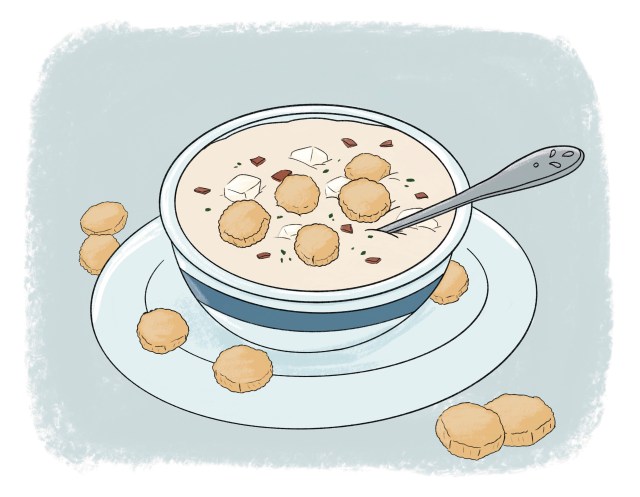For my entire childhood, there were a few things stocked in our pantry that remained constant through the years: crushed tomatoes (because you can never make enough red sauce for pasta), garlic powder, bouillon and oyster crackers.
I can still see the bag: “PREMIUM” scrawled across the top in blue lettering. Or, more often than not, just “MIUM” as the bag was usually folded and halfway empty. The nickel-size crackers were ever-present in our New England home, and I know we weren’t the only ones.
Oyster crackers somehow found their way into the New England zeitgeist, but not many know how or why. Also, what’s with their name? The buttery bite-size crackers don’t contain oysters – just enriched flour, baking powder, shortening, yeast, salt and sugar. In fact, they don’t have an obvious link to oysters at all. Or do they?
Read on to find out how that quintessential cracker got to be in your warm bowl of chowder, and even how to make your own.
The history of oyster crackers
The origin of the first batch of oyster crackers is up for debate. A baker named Adam Exton is credited with creating them in his New Jersey bakery, The Exton Cracker Bakery, in 1847. However, the title of creator is hotly contested by the Westminster Cracker Company, which claims to have developed the original oyster crackers in 1828.
Why are oyster crackers called oyster crackers?
Regardless of who invented oyster crackers, their name is even more of a mystery.
The first theory as to why oyster crackers are so named sends us back to the 1800s, way before oysters were considered the delicacy they are today. Back then, oysters were overfished and thus quite cheap. Because of this, they were added to a number of foods and many new dishes were created to support the mass amounts of them being brought in by fishermen on both coasts of the U.S.
One of the most popular dishes created during this oyster heyday was oyster stew. It’s therefore assumed by many that oyster crackers were created, and consequently named, solely to garnish oyster stew.
The next hypothesis is simpler. Some food historians believe the name for oyster crackers came about because of their slight resemblance to an oyster shell. It’s also possible, of course, that both schools of thought are true; perhaps the crackers were created to adorn oyster stew and afterward began to resemble the oysters themselves.
Either way, we’re just glad they’re around.

How did oyster crackers become chowder’s favorite companion?
Once oyster stew became a thing of the past, its crunchy adornment was able to stay popular. Why’s that? Durability.
As food trends shifted, the oyster cracker remained the best way to add a satisfying salty crunch to any soup. Their many layers keep them sturdy, even after they’ve absorbed some liquid. So, it’s no wonder why us New Englanders believe a bowl of white clam chowder is incomplete without a tiny packet of oyster crackers.
Can you make your own oyster crackers?
Why, yes you can! Picture it: you’ve just finished making a delicious clam chowder and can’t wait to dig in, when you come to find an empty box of store-bought oyster crackers in your pantry. Bummer. Luckily, they’re easier than you’d think to recreate. This recipe uses just six everyday ingredients you’re likely to have in the pantry right now.
If you’re not looking to make oyster crackers from scratch, try putting hot sauce on them like an Ohioan for a truly satisfying little snack, or making a ranch-flavored version like these.
Do you put oyster crackers on your chowder? Tell us your favorite way to eat them in the comments below.
This article has been updated and republished from a previous version.
15 Thoughts on “The Mysterious Origin of Oyster Crackers”
Leave A Comment
Comments are subject to moderation and may or may not be published at the editor’s discretion. Only comments that are relevant to the article and add value to the Your AAA community will be considered. Comments may be edited for clarity and length.
















Oyster crackers and chowder are such an ultimate pairing. I’ve been quite amused that every package I’ve been served is from Vermont- the only New England state without ocean frontage!
What happened to Pilot Crackers? They were always on our table when we had soup.
If you’re looking for something quirky to do, don’t miss the Westminster Cracker Festival in Westminster, MA in October where they celebrate everything cracker. AND you can pick up a case of their famous Oyster crackers at a low price!
I keep oyster crackers in the house because they are great to snack on, and I seize everyone’s packet when we go out to eat (if they get soup or chowda). I also keep them by my bedside to ward off nausea when my blood sugar drops too low before I rise for the day!
Ok.If I can”t spell clam chowder the way I want to I’m going to spill the beans. I once ate Clam chowder at the Gov. Bradford Restaurant in Provincetown. The oyster crackers were pretty darned good and were made by a company in Maryland.
Of course I put oyster crackers in my clam chowder. Not putting them in chowder is like eating it with clear broth! What??? I also can snack on them by the hand full.
Whether or not they invented them, Westminster Bakers Co still makes the best. I eat them as a snack! Yum!!!
The Original Oyster Crackers were [& still are] made by the Westminster Cracker Factory. Unfortunately, a couple of decades back, due to high costs, the “Factory” moved from it’s Westminster, MA location to one in Vermont. If anyone wanted to come to Westminster, at the turn heading to the Main Downtown Street, once off RTE 2, the huge red Factory building, complete with original Westminster Cracker signage, is still there. Come & take a pic!
We still get the Original Westminster Cracker packages & enjoy with our Soups, Stews & Chow[da’s/ders].
Why do oyster crackers go stale so quickly and get that ammonium like smell??
I always put the oyster crackers in the chowda. If some one else is having chowda. I try and weezle their crackers away for nibbling..
I struggled with my computer to spell chowder the way It should be spelled.
Me too, Paula! Can’t have “chowda” without ’em 🙂 Thank you for reading!
Sorry to say Sarah, but from what i know your article is mixing up 2 different crackers. Maybe dig a little deeper? The oyster crackers I know were indeed made in NJ but they were more the size of a Walnut, rather than a nickle. Those are no longer available. As I recall having discovered several years ago when searching for a source, the company that made them went out of business within the last 20 years or so. Some enterprising business tried to revive the product but found it was not feasible to restore the original machines that gave the cracker it’s unique character and too expensive to reproduce it. Those crackers were often found in bars in NJ and around Philadelphia much as Pretzels can be found in some bars today. Because they were offered for free they did not fit into the standard capitalist supply demand curve, which contributed to their demise, not being able to demand a higher price when it became necessary.
All of that is from memory of the research I did back then, which left me quite disappointed to nt be able to obtain the Oyster Crakers I remember from my grandmother’s kitchen. Nice to hear New Englanders appreciate what i consider a poor substitute for the real thing. They don’t know what they are missing.
Hi Jim, thanks for reading and appreciate the feedback!
I thought they were called Erster crackers because every so often in Brooklyn we found one in the shell.
A company near Souderton, PA is now making a cracker very similar to the OTC. Coincidently (or not), the name is Old Towne Cracker Company. I was happily surprised, and now have bought them several times.